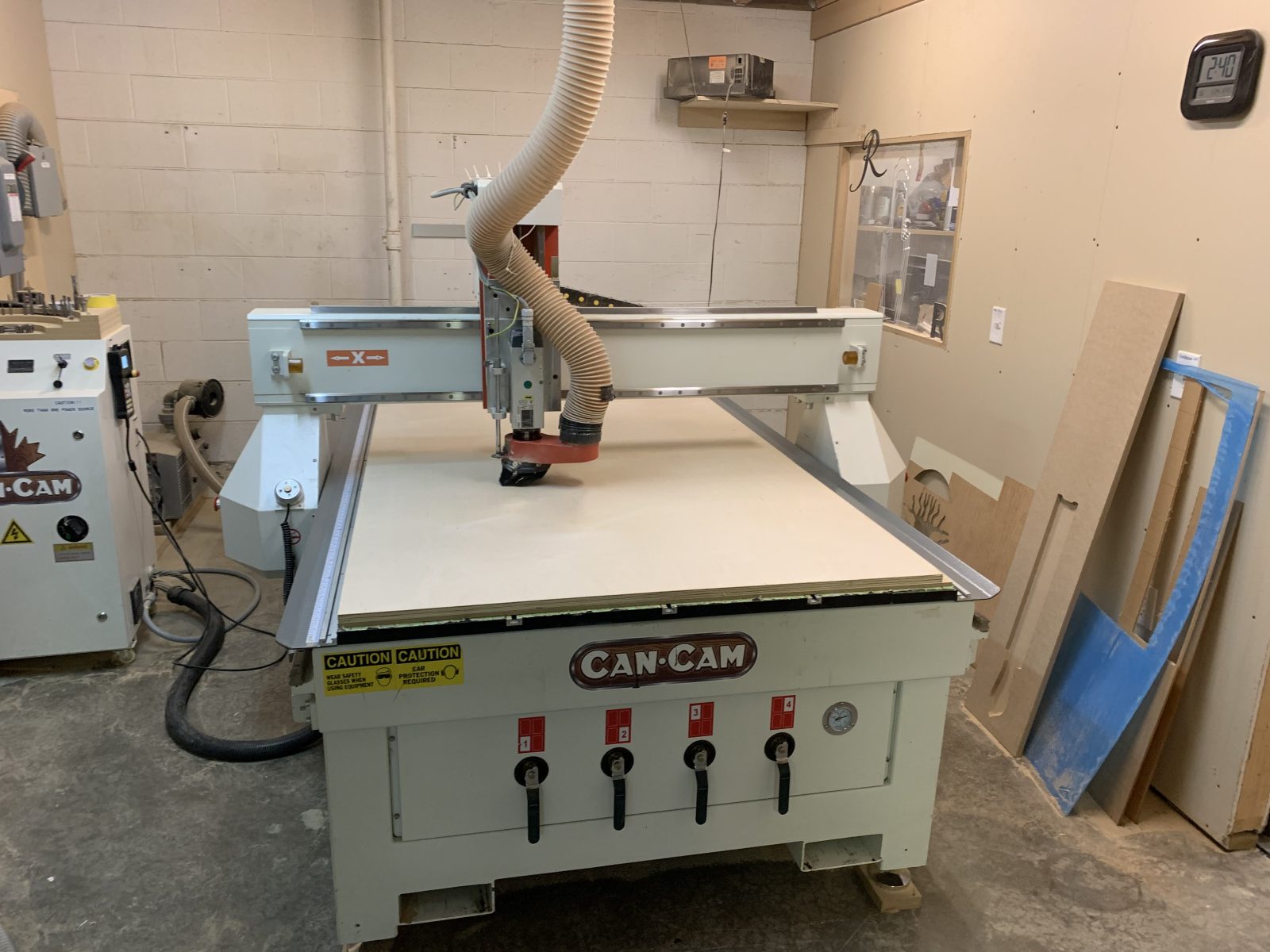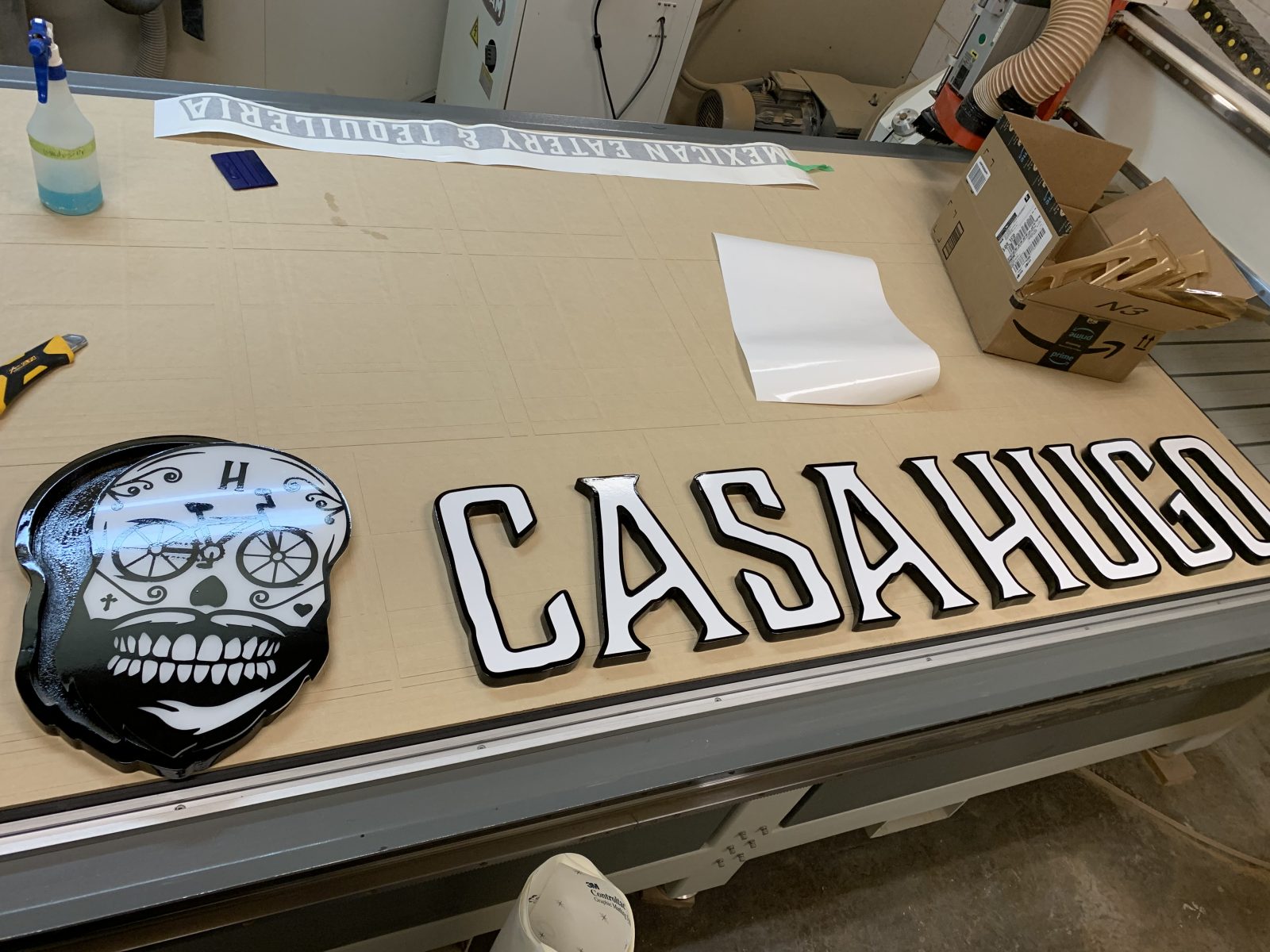Coastal Enterprises, manufacturers of Precision Board HDU, is proud to host guest blogs written by some of the signage industry’s biggest movers and shakers, posted to the Precision Board Blog. This guest blog is written by Rex Harrison with Harrison Solutions, based in Ontario, Canada. Rex tells us how he designed and fabricated the dimensional sign for the Casa Hugo Mexican Eatery & Tequileria, a local restaurant, and then fills us in on some tricks to cleanly rout Precision Board and light up different elements of the sign using backlights and halo lights.
Q & A with Rex Harrison…
Tell us what the sign project was?
The project was directed to me through a colleague/friend. We work together on projects occasionally, as he is another craftsman in the realm of signs, He is the man behind Stevensville Pallet Project here in the Niagara Region of Ontario. He was approached by the manager of the Casa Hugo Restaurant because SPP had done a personal job for the manager. SPP felt that this type of project was best suited for me and my approach because of the scope and complexity of the project. Since we work together frequently, he knows my style and quality, so he knew that I was the guy to take care of his customers as well as he did himself.
The owner of the establishment, Dave, was in the very last stages of his pre-opening chaos when he reached out in regards to the sign, so it was crunch time, and we had no time to spare. We discussed his ideas, and his logo and branding, and we came up with a game plan and concept fairly quickly. I initially provided him with multiple examples and drafts, and we narrowed it down and customized it until he was certain that he would get exactly what he wanted. I have always based my approach to customers on the concept that I will get in their head to see their vision and make that happen, regardless of what I had preconceived. I will obviously guide them and suggest certain things based on my experience and knowledge, but ultimately, the customer should get what they want. Nothing would be worse than for a business owner to come to work everyday and have to look at a sign they aren’t 100{afbea94bd31582343c3017644f03ec8d7d8fa2386ecb82c250661e06c0c6e111} happy with. So once we agreed on the final design, I gave him my timeframe of construction and assembly, which was a few days past his grand opening. He knew that he had waited too long for this crucial piece of his business, but I assured him that it would be done proper and would be done before his first big weekend.

Why use Precision Board HDU?
I use Precision Board HDU because of how it machines, how it finishes, how it stays true (no shrinkage, no warping, no rotting, no breakdown), and because of how strong it actually is compared to the other brands. In terms of machining, I use a cnc router table with vacuum hold-down, and the Precision Board cuts so cleanly and maintains a super crisp edge, unlike the other large brands, that appear to be more “plastic” like when cut. The Precision Board sands very quickly and easily, which helps me increase production time, and also helps me keep a very flawless finish when a high gloss coating is applied. And the fact that I can rely on it to be “true” in composition means that I can accomplish complex features with machine level accuracy. Also, the lightweight nature of it makes installation and transportation a breeze. A huge selling feature is that it is environmentally-friendly, and at the same time, isn’t a material that bugs would want to eat into.
What density of Precision Board did you use?
I have only ever used the 15lb density (PBLT-15), because that is strong enough for my applications. 99{afbea94bd31582343c3017644f03ec8d7d8fa2386ecb82c250661e06c0c6e111} of my signs are wall mounted, out of reach of most things that would exert any level of pressure or pulling. But in the event that I needed a stronger structure, I would certainly upgrade to the tougher, higher density Precision Board HDU (Ed note: Precision Board comes in 16 densities ranging from 4lb to 75lb).
What was your routing time with the Precision Board HDU and your speeds and feeds settings?
I used a 3/8″ double-flute compression chip-breaker end-mill from Royce-Ayr to machine the parts for this sign. The feed speed was 100mm/sec, and the spindle speed is 20,000 RPMs with a 4hp spindle. I do the outside cuts in two passes, for two reasons. The first pass may leave behind some debris in the toolpath, and the second pass allows the dust collector to evacuate all of the remaining material, which keeps me from having to clean it manually later. The second reason is that the second pass is only cutting through a very thin layer left behind from the first pass, which allows the suction bed to keep a hold on the parts/letters as if they were still a full sheet and not have the bit fighting against hardly any material while it makes the bottom edge of the part/letter have a perfect face edge.
What brand of CNC do you use? Software? Router bits?
I use a 4′ by 8′ CanCam CNC router table with a 4hp spindle and vacuum hold-down. I use a range of software for different applications, but essentially, my toolpaths are created with Vectric VCarve Pro. And my bits are purchased from Royce Ayr.
What did you prime & paint the Precision Board urethane foam with?
I use Transtar Autobody Technologies paint products on all of my jobs. They are designed for the automotive world, which means they can take the exterior abuse, and will last over time. And it finishes very well. I use a gravity-fed air paint gun for the application of the finishes. Once painted, I applied contour cut gloss white vinyl letters to the face of the Precision Board letters that had been scaled down by 1/4″ to allow for the black border around the white lettering.
Talk about how you lit the HDU letters and skull up?
The large CASA HUGO letters are back-lit and halo-lit, which is accomplished by rebating a pocket into the back of the letter (with the cnc router) deep enough to allow the led strip lighting to be mounted to the walls of the pocket and a layer of 1/8″ clear acrylic that is sealed off with clear silicone. That takes care of the backlighting.
For the halo effect, I simply cut out the letter shape again, this time using the cnc laser cutter and 1/4″ translucent white acrylic. This layer is glued to the individual letters, and once applied to the back wall surface, the light can be seen through the translucent layer and spreads out across the background.
As for the Skull and MEXICAN RESTAURANT & TEQUILERIA parts, they were rebated/pocketed into the Precision Board as well, but from the face down, not the from the back down. Same method of installation with the led light strips, but instead of using 1/8″ clear acrylic to seal off the pocket, I used 1/8″ translucent white, which gives the letters and detail of the skull the bright white glow we needed, to match the larger CASA HUGO letters.
How was the sign installed?
The spot in the wall for the sign had been pre-designed when the building exterior was completed, so I basically had this part pretty easy. I ran the power wires together to a main focal point, drilled a hole through the building ball, which was just a layer of plywood with some sheathing, and into the building through the plastic wall material used inside. I secured the sign panel to the wall using 2″ #8 Robertson exterior screws, which matched the finish of the rusted roof tile background perfectly. Once inside, the power supply was connected and switched on.
Any tips or tricks to using Precision Board HDU?
With the 15lb density Precision Board, I always take extra care when applying pressure when manually sanding prior to the primer coat. Also, I make sure I stay away from anything that might bump into it, as the lower densities can dent more easily prior to a primer coat. I’m sure the higher density boards would be more resistant to these types of things (Ed note: Yes! Higher densities have a harder and smoother surface). Also, when priming the machined parts, the end grain (area inside the board that the machine cut) is porous and soaks up a lot of the primer. Simply apply a thicker layer of primer, or do multiple coats to seal off the end grains.
Rex Harrison is essentially a one-man show, doing all of the designing, purchasing, machining, fabrication, wiring, installation, and service himself. He prides himself on being neurotically attentive to detail, because his work represents how much he wants it to be the best sign his customer could possibly purchase. Rex does more than just signs, ranging from machining parts for other shops in town, creating custom cabinetry, and consulting work for other sign/retail display companies. He can be found on his Facebook page for Harrison Solutions.
Coastal Enterprises manufactures Precision Board HDU, a versatile, cost-effective and eco-friendly urethane sign material that is particularly effective for making professional-looking indoor and outdoor dimensional signs. It is a closed-cell rigid substrate that does not rot, warp or crack. You can request free samples, get a quote or sign up for periodic newsletters packed with helpful information.


